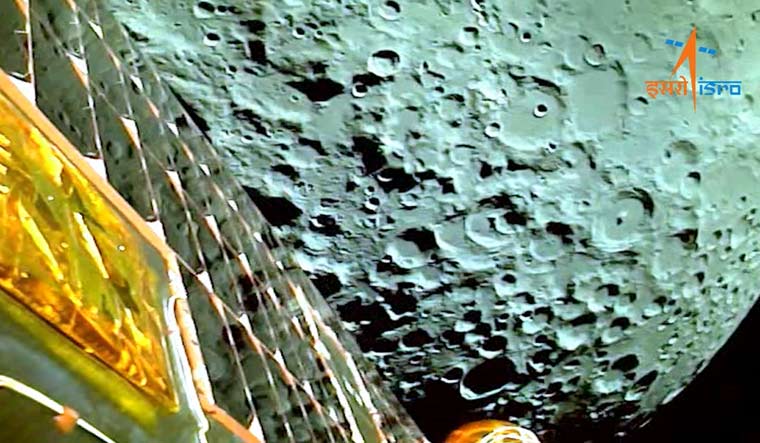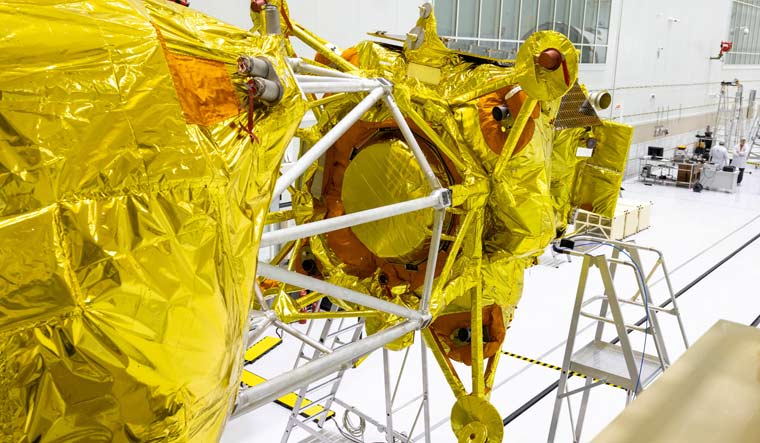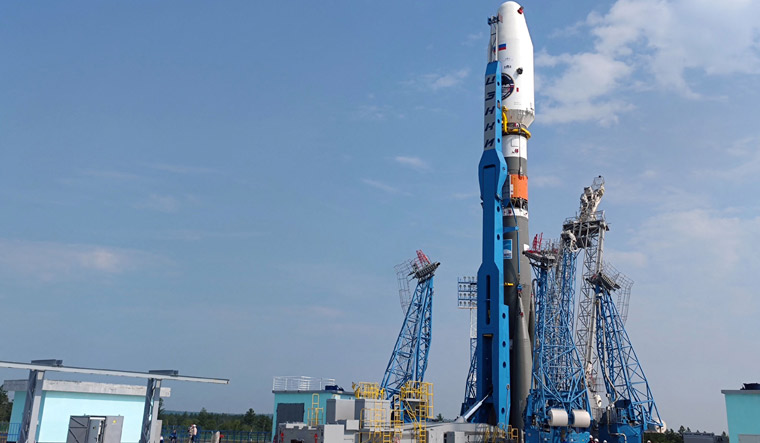Russia is poised to launch its lunar lander, Luna-25, marking its first moon landing since 1976. After several delays, the Russian space agency, Roscosmos, has set the launch date for this week, seeking to rekindle the country's space exploration legacy. The Luna-25 lander, weighing around 800 kilograms, is scheduled to touch down in the region of the moon's south pole.
This endeavour places Russia in direct competition with India's Chandrayaan-3 mission, which is also targeting the lunar south pole and is due to land later in August. On August 4, the Indian Space Research Organisation (ISRO) announced that Chandrayaan-3 has completed approximately two-thirds of the journey to the Moon.
 A view of the moon as viewed by the Chandrayaan-3 lander during Lunar Orbit Insertion on August 5, 2023
A view of the moon as viewed by the Chandrayaan-3 lander during Lunar Orbit Insertion on August 5, 2023
The decision to focus on the moon's south pole is strategic. Scientists believe this area contains substantial amounts of ice, potentially offering vital resources for future lunar missions, such as fuel, oxygen, and drinking water. While the rough terrain poses challenges for landing, both Russia and India are determined to unlock the potential of this prized destination.
The launch will take place from the Vostochny cosmodrome, situated 5,551 kilometers east of Moscow. This launch site was chosen to replace the previous Baikonur Cosmodrome, which now resides in Kazakhstan, after the dissolution of the Soviet Union. The Luna-25 spacecraft will take approximately five days to reach the moon, followed by five to seven days in lunar orbit before its descent. This timeline suggests that Russia's lander could match or narrowly beat India's Chandrayaan-3 to the moon's surface.
The two missions have distinct landing areas to avoid any interference. Roscosmos has assured that "there is enough space for everyone on the moon." Chandrayaan-3 plans to conduct experiments for two weeks, while Luna-25 aims for a more extended stay, conducting scientific research for a year.
The launch of Luna-25 is a significant milestone for Russia, marking its return to lunar exploration after a hiatus of almost five decades. It reflects the country's determination to continue its space program despite various challenges. The last lunar sample return mission conducted by the Soviet Union was the Luna-24 mission, which successfully obtained samples of lunar soil and brought them back to Earth for analysis.
As both Russia and India race to explore the lunar south pole, the scientific insights gained and potential resources discovered could pave the way for humanity's sustained presence on the moon in the future.
Despite geopolitical challenges, Russia remains committed to its lunar program. The Luna-25 mission represents the latest step in the country's endeavors to advance its space exploration efforts. Roscosmos has stated that the primary objective of the mission is to advance the fundamental technologies necessary for achieving a gentle touchdown in the polar region and carry out detailed investigations of the lunar south pole through physical contact.
 Luna-25, the lunar landing spacecraft, will search for ice near the south pole of the Moon
Luna-25, the lunar landing spacecraft, will search for ice near the south pole of the Moon
This lunar mission uses "a completely Russian element base and the latest achievements in the field of space instrumentation," according to Lavochkin, the organisation behind the spacecraft's development.
This mission, however, does carry an element of risk, with the complex task of landing in the challenging terrain of the circumpolar region. The Luna-25 mission presents a unique challenge for Russian space engineers as it involves a new type of spacecraft for which they have no recent comparable experience. Furthermore, it marks the first use of the Soyuz 2 rocket for a lunar mission and the first such mission to take off from the Vostochny space complex. Combining these multiple "firsts" makes the mission quite a daring endeavor. Yuri Borisov, head of Russia's space agency Roscosmos, acknowledged this high-risk nature during a meeting with President Putin. The probability of successful completion is estimated at around 70 percent.
Russia has plans to deploy a full-fledged scientific station on the Moon in collaboration with China, following the Luna-25 mission.


